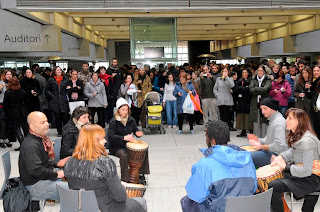This is the title of the text that won the
"El·lipse award", organised by the
PRBB last year for the first time. I already mentioned the El·lipse awards in an
earlier post, but we now have the English translation of the winner (written category) - courtesy of
Global Talent, so I thought it would be worth posting it heres, so more people can enjoy it!
So, here it is:

Marga Nadal, 1st El·lipse prize of Scientific Dissemination,
in the category of written work
"
Letter to a young scientist"
Dear lady,
I received your mail a few days ago and have had it marked with one of those flags until now when I have found a moment of inspiration to answer you. You ask me if research on stem cells will have such an impact as those who understand it foresee, and my immediate response would be no. Even as we scientists have always been proud of being at the margin of fashions, one only needs to have a look at the most prestigious publications of the latest years and one will realize that it is absolutely not true. Scientists and the media who are minimally aware of what we do, have become experts in generating great social expectations and many of us have continued the onslaughts of these gales. Just think for a moment where genetic therapy had to take us and where it has finally taken us. I wouldn't, in any way, want to sin by being pessimistic and I wouldn't want to make you lose this enthusiasm that you have timidly shown towards research, but I would like you to understand that science is still far from being able of resolving all the imperfections of nature. Stem cells, as you know, are the branch parts for excellence, our pantry; their potential to become any cell is absolute at least in the embryonic stage, the very first ones.
The reasoning is therefore simple: if the liver needs a spare liver we only need the stem cells to become liver; if we need neurons, we transform them into neurons and this way, ad líbitum, without limitations. But what needs to be understood is, as always, the mechanism of this metamorphosis. For you to better understand it, if you have never walked along Chillida Leku, you will realize that the sculptures are all different, made of different materials, forms and dimensions and independently of whether you like them or not, they all come from a stone block, of granite, basalt, even of iron or whatever, but the author's imprint is unmistakable.
So, stem cells are the stone block which can be turned into a sculpture, any sculpture, the lining of the scale of the steps at home or simply, remain forever at the quarry. Man or artist is the one who, with his need or expertise, will transform the stone into slab or sculpture. But the stone also transforms by itself: put a stone or sandstone, polished or natural, shiny and white in your house and you will see how it initially will be the envy of neighbours and maybe even someone would want to publish it in a decoration magazine, but you will also see, as just some little time later the stone will have aged, well or badly, but it will have aged, by itself. And the ageing will be different according to whether it has been a humid winter or an especially dry summer, initially very unpredictable, of course.
Stem cells, dear lady, are the stones which can turn into anything the sculptor wishes, and we know it, what we don't know yet is who will sculpt them and how they will age.
I know that with everything I have just told you, I have probably disappointed you or even worse, I will have taken from you in one goes that part of vocation that is essentials to spend a lifetime in a laboratory. I guess this was part of the possibilities you contemplated when you sent me the mail. I also have to tell you that, even if I didn't warn you at the beginning, that I don't consider myself an expert in stem cells and that therefore my opinions shouldn't be regarded too seriously. Even so, dear friend, just think that stem cells are, whatever I may say, a nature's mystery that deserves all the attention of eminent scientists who leave all their energy in the search of sculptors.
Always yours,
TS









